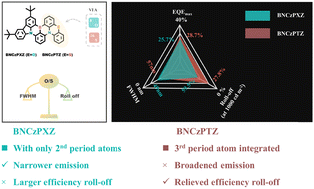A comparative study of two multi-resonance TADF analogous materials integrating chalcogen atoms of different periods†
Abstract
Two multi-resonance (MR) thermally activated delayed fluorescence (TADF) analogous materials, BNCzPXZ and BNCzPTZ, respectively integrating oxygen and sulfur elements were compared to in-depth investigate the influences of introducing elements of different periods. Both compounds show similar photophysical profiles in terms of absorption and emission positions, bandgaps, etc., while exhibiting distinct differences in detailed characteristics. On the one hand, compared to BNCzPXZ only containing oxygen, a second period element, BNCzPTZ with sulfur, a third period element, shows accelerated reverse intersystem crossing due to the heavy atom effect. On the other hand, the similar size of an oxygen atom to carbon atom helps BNCzPXZ to better maintain the narrowband character compared to BNCzPTZ with large size sulfur. Therefore in OLEDs, BNCzPTZ exhibited an improvement in the maximum external quantum efficiency and relative roll-off, while BNCzPXZ is better in terms of emission bandwidth and color purity. This work clearly reveals the advantages and shortcomings of MR-TADF analogs incorporating chalcogen atoms of different periods, and would enlighten the development of MR-TADF emitters and OLEDs with simultaneously superior efficiency, low roll-off and narrowband emission.



 Please wait while we load your content...
Please wait while we load your content...